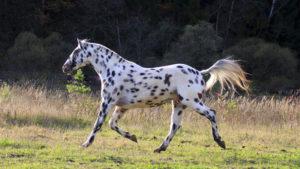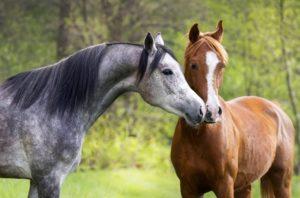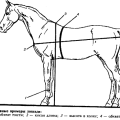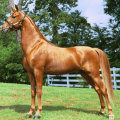How many months does a pregnant horse walk and how is childbirth going?
Reproduction of livestock, obtaining healthy offspring are one of the main tasks of horse breeding farms. Pregnancy and childbirth in mares, caring for young animals require increased attention from the owners. Enhanced nutrition, comfort and care should be provided before and after childbirth. Consider how many months a pregnant horse walks, how to determine fertility and help a mare give birth to a healthy foal.
Content
Hunting for mares
At the age of one and a half years, mares become sexually mature and ready to conceive. But the first mating is usually allowed only at 3-4 years old, when the body is fully formed and ready to bear.
Hunting in mares is the time, state of the body and behavior in which animals actively want to mate, let the horses come close to them. This period lasts from 2 to 14 days, most often a week, and occurs, on average, every 20-21 days. Hunting time can be determined by a number of signs:
- frequent neighing;
- excretion of urine in small portions;
- often lifts tail, puts hind legs wide;
- slight swelling of the genitals and whitish discharge;
- loss of appetite.
When approaching and attaching a stallion, the horses do not fight back, they show readiness for mating. At stud farms, specialists should monitor the appearance of hunting in mares, if not, contact a veterinarian. The specialist will determine the sexual cycle and the appropriate time for mating.
Note: March-April is considered the best time for love affairs, but no later than mid-July. This will create favorable conditions for the young.
Definition of horse pregnancy
By eye, fertility can be determined only after 6 months. Such terms are not convenient for horse breeders. 2 weeks after conception, pregnancy can be confirmed by ultrasound diagnostics and laboratory methods that cannot be called cheap.
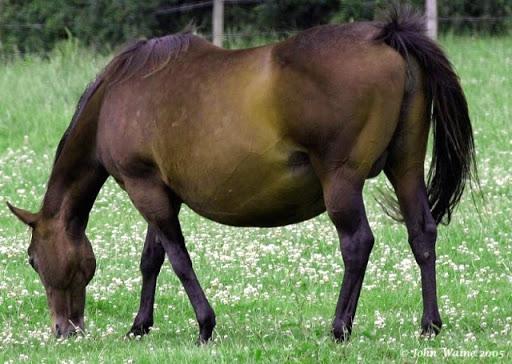
It is possible to identify pregnancy by external signs - the behavior of the mare:
- decrease in activity and agility - the mare sleeps more;
- increased appetite;
- when keeping herds away from others.
At home, the owners determine conception by the lack of desire to mate, which appears regularly in non-fertile horses. In later stages of pregnancy, you can find out by the recumbent position, which becomes a favorite in the mare, an increase in the udder. Veterinarians determine the fertility by rectal and vaginal examinations, palpation of the peritoneum in the left part of the palpation is felt.
How long does it take to bear a baby?
The average gestation period for a calf is 11 months (340 days). This time is enough for the full development of the fetus.In reality, the terms can be shifted and depend on a number of factors:
- horse health;
- features of the course of pregnancy;
- proliferation;
- primiparous mare wears longer - up to 12 months;
- pregnancy with a male foal lasts an average of 2 weeks longer.
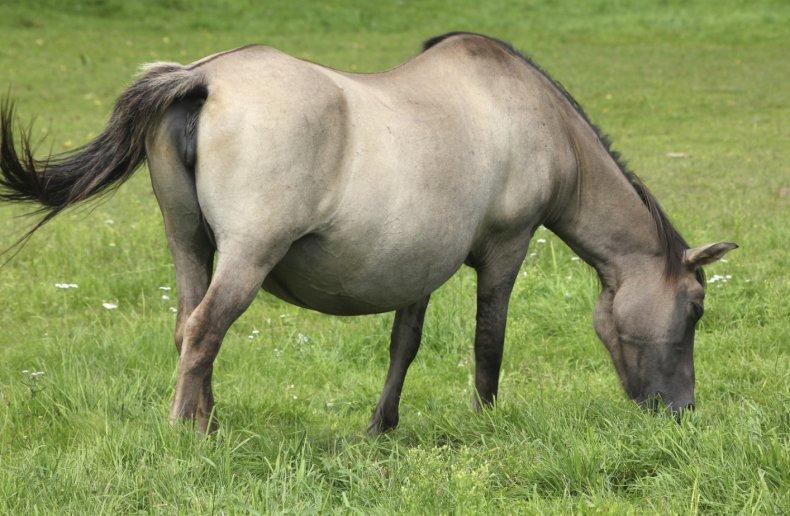
Mares can walk in foals for 310-370 days, this fits into physiological norms.
Number of foals
In most cases, one foal is born. The birth of twins is a rare and unsafe case. In childbirth, one of the babies most often dies. In the absence of proper help with foaling and effective nursing, you can lose both. Surviving foals lag behind their peers in development.
How to care for a pregnant mare
A timely detected pregnancy makes it possible to adjust the diet, exercise and care of the horse, which will help the fetus develop and prepare the animal for childbirth. Necessary care items:
- Feeding. The first months, the fetus grows slowly, the diet is increased by 40% by the end of the term (last 3 months). Portions are reduced, fed fractionally (5-6 times) in order to reduce the load on the digestive tract. They use only high-quality feed - no signs of rot, stagnation. Eliminate fermenting foods. Includes vitamin supplements, fresh apples, carrots.
- The water is only warm, a cold horse can cause miscarriages, colds.
- Works. The loads are gradually reduced, although the mare can perform light work almost until delivery (they are released 3 weeks before the expected date).
- Walked. Daily walking is necessary for mares to prevent swelling of the limbs and abdomen. At the end of the fertility, the horse wants to lie down, which leads to fluid stagnation and difficult labor. You need to walk the mare regularly, excluding only bad weather. Ice is especially dangerous.
- Content. The box needs to be ventilated, provided ventilation, warmth and comfort. The litter is changed regularly. When grazing for the night, they are taken to the stable.
- Care. Rough handling, hard work is excluded. Shouting, disturbing the calmness of the horse, using a whip is prohibited.

In the second or third month, the mare may have sexual heat. The animal must be monitored, to exclude contact with the stallion, which can provoke a miscarriage.
What you need to prepare before giving birth
A special stall where the mare will foal is prepared in advance. It is better to choose a quiet place, away from other horses. The room is cleaned, objects are taken out with which you can get hurt. Disinfection of walls and floors. Pour in clean straw. If other horses are in the neighborhood, the bars are hung.
In most cases, with a normal birth process, the mare will cope on her own, she will not have to help. The vanity and care of a person will only hinder her.
Signs of an approaching foal
The fact that childbirth will begin soon can be understood by a number of signs:
- Behavior change. Anxiety, fussiness - the foal horse gets up, lies down again, looks at the tail.
- Genital organs. Puffy labia, thinner discharge. Lubrication liquefaction occurs 1-2 days before the foraging.
- Swelling of the udder, sometimes colostrum.
- Some mares have excessive sweating.
The mare's pelvis turns into a "generic" one, the ligaments weaken, their structure becomes loose and more pliable. Changes will start 12-36 hours before foraging.

Childbirth process
During childbirth, it is better not to interfere with the mare - the process consists of attempts, during which the fetus moves along the birth canal. The horse becomes covered with sweat with effort, often rolls over. Mares give birth in a prone position, less often standing. In the normal course of the foal, the forelimbs and the adjacent foal's head appear first. If this happens, the further process will proceed normally. Veterinarian assistance may be required if there are two fetuses or the baby's hind legs first appeared.
The amniotic fluid often breaks itself, if necessary, it is cut. After giving birth, the horse usually stands up, the umbilical cord breaks off naturally. If the rupture does not occur, the tourniquet is cut with sterile scissors. The umbilical cord of the foal is treated with iodine.
Childbirth usually lasts 30-40 minutes, when twins are born, the second appears with an interval of 20 minutes. Foals are weakened, often aggressive, they are separated, provide the necessary assistance. The mare will sometimes recognize and feed only one baby.

Reference: the weight of the foal is 30-40 kilograms, which is 10-15% of the mother's weight. Larger horses (draft horses) give birth to larger cubs.
Postpartum care
Immediately after giving birth, the horse carefully licks its cub, remembers its smell. Licking plays the role of a firming massage, serves to raise the foal's immunity.
For mom
The litter soiled during childbirth must be removed from the stall, replaced with fresh straw. Within an hour, the afterbirth comes out, you need to make sure that it has completely departed, decomposed and checked for integrity. Otherwise, the remnants of the placenta in the uterus will lead to the development of inflammation. The horse often eats the afterbirth, it should not be disturbed - it contains a lot of valuable substances. When the mare dries up from sweat (it is important to ensure that there are no drafts), she is watered with warm water and fed with high-quality hay.
If the birth took place without pathologies, the horse does not need special care. The bedding is changed every day, as the bleeding lasts 7-8 days. Monitor the condition of the udder.
After 2-3 weeks, the mare's body is restored, she reappears sexually. When to carry out the next mating, the owner decides. It is considered that the horse should be allowed to rest for 1-3 months before the next pregnancy.

Behind a foal
The mother sniffs, licks the cub, barely catching her breath. If the mother is too tired, the foal should be wiped off. Veterinarians usually check breathing. In the first hour, the foal is already on its feet, the condition of the limbs should be monitored. The baby quickly begins to look for the udder (after 1-2 hours). If the foal does not try to suck, the horse's milk is decanted and fed from a bottle. Meconium comes out in the first 2-3 hours. If there is no stool, the baby is given castor oil. For 5-6 months, the foal must be with its mother in order to eat on time and develop fully. In the first months, the baby sucks the udder up to 40 times a day.
Possible problems
Complications can occur during childbirth and after foaling:
- the fetus goes with its hind legs - urgent veterinary assistance is required;
- labor is weak, the fetus does not move every 10 minutes;
- the afterbirth does not come off - manual extraction may be required;
- the foal does not breathe, the heart does not beat - the baby will need resuscitation, heart massage;
- ruptures, red color of the bladder - the foal needs resuscitation measures;
- infection can be assumed by the yellow or green color of the bladder, the unnatural color of the baby - treatment of the mother and foal will be required;
- meconium does not go away - help is needed in emptying the intestines;
- the baby cannot stand up - congenital limb pathologies.
The mare should not be interfered with during childbirth, sometimes grooms and other staff are overly interested in the process, distract and frighten the woman in labor. The veterinarian should help only when problems arise - slowing down the labor, improper exit of the fetus.
In most cases, horses do an excellent job of foaling on their own, they themselves bring the baby. During pregnancy, you need to feed the mare well, do not put on hard work, control the load or training. Then the horse will be healthy and strong for childbirth, instincts will tell her the right actions, she will give birth to a healthy foal.
